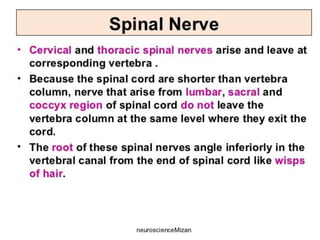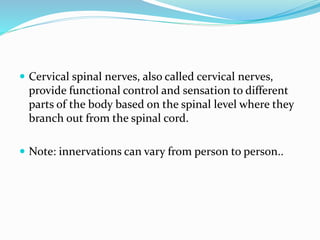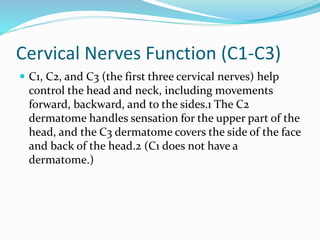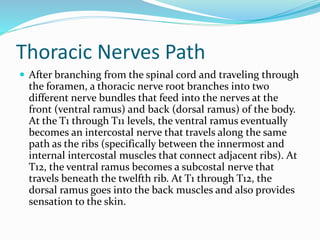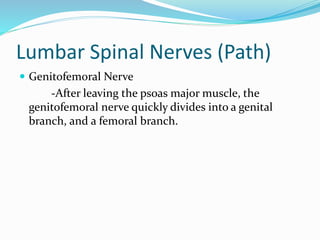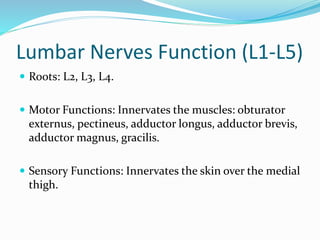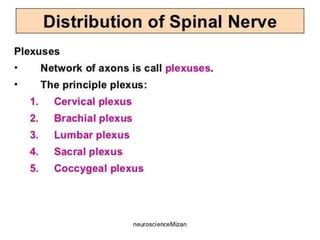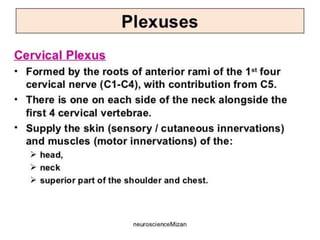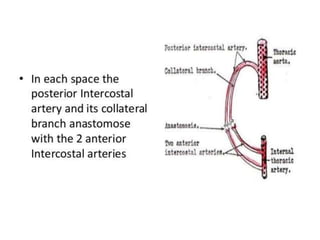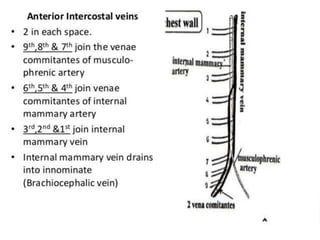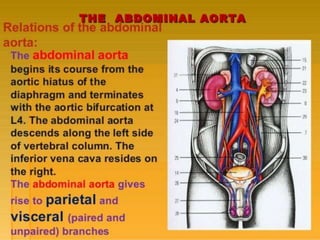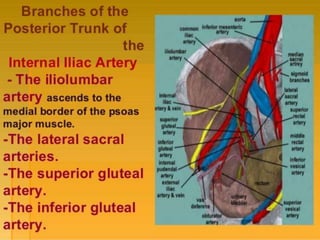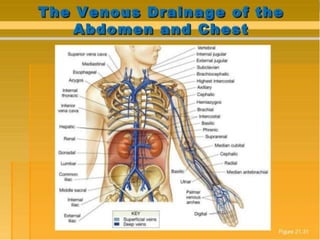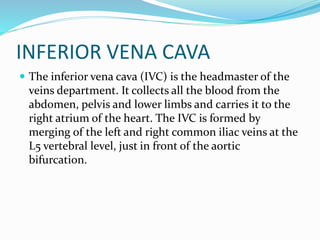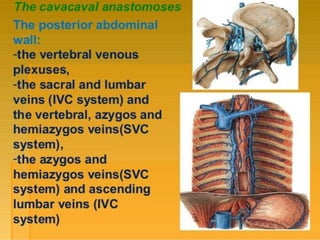Lesson 4 (Nerves and Blood Vessels of the Spinal Column and Thorax).pptx
- 1. Lesson 4 NERVES AND BLOOD VESSELS
- 3. Introduction The thoracic region of the body showcases the remarkable complexity of human physiology. Nerves, blood vessels, and arteries in this critical region enable sensation and allow blood to flow throughout the entire body.
- 4. What to expect: Nerves a detailed explanation on each spinal region location, function and movement. (e.g. Cervical Spinal Nerves C1-C8’s individual purposes) Blood Vessels A portioned illustration/explanation on different parts of the trunk ( abdomen and neck)
- 15. Cervical spinal nerves, also called cervical nerves, provide functional control and sensation to different parts of the body based on the spinal level where they branch out from the spinal cord. Note: innervations can vary from person to person..
- 17. Cervical Nerves Function (C1-C3) C1, C2, and C3 (the first three cervical nerves) help control the head and neck, including movements forward, backward, and to the sides.1 The C2 dermatome handles sensation for the upper part of the head, and the C3 dermatome covers the side of the face and back of the head.2 (C1 does not have a dermatome.)
- 18. Cervical Nerves Function (C4) C4 helps control upward shoulder movements.1 C4 (along with C3 and C5) also helps power the diaphragm—the sheet of muscle that stretches to the bottom of the rib cage for breathing.1 The C4 dermatome covers parts of the neck, shoulders, and upper part of arms.
- 19. Cervical Nerves Function (C5-C8)
- 20. Cervical Nerves Function (C5-C6) C5 helps control the deltoids (which form the rounded contours of the shoulders) and the biceps (which allow bending of the elbow and rotation of the forearm).1 The C5 dermatome covers the outer part of the upper arm down to about the elbow. C6 helps control the wrist extensors (muscles that control wrist extension) and also provides some innervations to the biceps.1,3 The C6 dermatome covers the thumb side of the hand and forearm.
- 21. Cervical Nerves Function (C7-C8) C7 helps control the triceps (the large muscle on the back of the arm that straightens the elbow) and wrist extensor muscles.1,3 The C7 dermatome goes down the back of the arm and into the middle finger. C8 helps control the hands, such as finger flexion (handgrip).1,3 The C8 dermatome covers the pinky side of the hand and forearm.
- 23. Thoracic Spine The thoracic spine has 12 nerve roots (T1 to T12) on each side of the spine that branch from the spinal cord and control motor and sensory signals mostly for the upper back, chest, and abdomen.
- 24. Thoracic Nerves’ Function (T1-T12) The thoracic spine (highlighted) spans the upper and mid-back. It includes twelve vertebrae named T1 through T12
- 25. Thoracic Nerves Path Each thoracic spinal nerve is named for the vertebra above it. For example, the T3 nerve root runs between the T3 vertebra and T4 vertebra. There are 12 thoracic spinal nerve root pairs (two at each thoracic vertebral level), starting at vertebral level T1-T2 and going down to T12-L1. Each thoracic nerve root exits the spinal canal through a bony hole, called an intervertebral foramen. This bony hole is formed by two adjacent vertebrae, and its size and shape can slightly shift as the vertebrae move.
- 26. Thoracic Nerves Path After branching from the spinal cord and traveling through the foramen, a thoracic nerve root branches into two different nerve bundles that feed into the nerves at the front (ventral ramus) and back (dorsal ramus) of the body. At the T1 through T11 levels, the ventral ramus eventually becomes an intercostal nerve that travels along the same path as the ribs (specifically between the innermost and internal intercostal muscles that connect adjacent ribs). At T12, the ventral ramus becomes a subcostal nerve that travels beneath the twelfth rib. At T1 through T12, the dorsal ramus goes into the back muscles and also provides sensation to the skin.
- 27. Thoracic Nerves Function (T1-T5) T1 and T2 (top two thoracic nerves) feed into nerves that go into the top of the chest as well as into the arm and hand. T3, T4, and T5 feed into the chest wall and aid in breathing.
- 28. Thoracic Nerves Function (T6-T12) T6, T7, and T8 can feed into the chest and/or down into the abdomen. T9, T10, T11, and T12 can feed into the abdomen and/or lower in the back.
- 30. Lumbar Spinal Nerves The lumbar plexus is a network of nerve fibres that supplies the skin and musculature of the lower limb. It is located in the lumbar region, within the substance of the psoas major muscle and anterior to the transverse processes of the lumbar vertebrae. The plexus is formed by the anterior rami (divisions) of the lumbar spinal nerves L1, L2, L3 and L4. It also receives contributions from thoracic spinal nerve 12. In this article, we shall look at the anatomy of the lumbar plexus – its formation and major branches.
- 32. Note: On the following slides, we’ll tackle about the intersecting path of the lumbar nerves (from the roots to the muscle then back to the roots again.)
- 33. Lumbar Spinal Nerves The spinal nerves L1 – L4 form the basis of the lumbar plexus. At each vertebral level, paired spinal nerves leave the spinal cord via the intervertebral foramina of the vertebral column. Each nerve then divides into anterior and posterior nerve fibres. The lumbar plexus begins as the anterior fibres of the spinal nerves L1, L2, L3, and L4.
- 34. Take this picture as reference on the following explanation regarding Lumbar Nerves:
- 35. Lumbar Spinal Nerves (Path) Iliohypogastric Nerve -The iliohypogastric nerve is the first major branch of the lumbar plexus. It runs to the iliac crest, across the quadratus lumborum muscle of the posterior abdominal wall. It then perforates the transversus abdominis, and divides into its terminal branches.
- 36. Lumbar Nerves Function (L1-L5) Roots: L1 (with contributions from T12). Motor Functions: Innervates the internal oblique and transversus abdominis. Sensory Functions: Innervates the posterolateral gluteal skin in the pubic region. ------ (Tip: an easy way to remember that the IlioHypogastric comes before the IlioInguinal is that H comes before I in the alphabet!)
- 37. Lumbar Spinal Nerves (Path) Genitofemoral Nerve -After leaving the psoas major muscle, the genitofemoral nerve quickly divides into a genital branch, and a femoral branch.
- 38. Lumbar Nerves Function (L1-L5) Roots: L1, L2. Motor Functions: The genital branch innervates the cremasteric muscle. Sensory Functions: The genital branch innervates the skin of the anterior scrotum (in males) or the skin over mons pubis and labia majora (in females). The femoral branch innervates the skin on the upper anterior thigh.
- 39. Lumbar Spinal Nerves (Path) Lateral Cutaneous Nerve of the Thigh -This nerve has a purely sensory function. It enters the thigh at the lateral aspect of the inguinal ligament, where it provides cutaneous innervation to the skin there
- 40. Lumbar Nerves Function (L1-L5) Roots: L2, L3 Motor Functions: None. Sensory Functions: Innervates the anterior and lateral thigh down to the level of the knee.
- 41. Lumbar Spinal Nerves (Path) Obturator Nerve The obturator nerve is a major peripheral nerve of the lower limb. The obturator nerve is formed from the lumbar plexus. It receives fibres from the anterior divisions of L2, L3 and L4. After its formation, the obturator nerve descends through the fibres of the psoas major and emerges from its medial border. It then travels posteriorly to the common iliac arteries and laterally along the pelvic wall – towards the obturator foramen of the pelvis.
- 42. Lumbar Nerves Function (L1-L5) Roots: L2, L3, L4. Motor Functions: Innervates the muscles: obturator externus, pectineus, adductor longus, adductor brevis, adductor magnus, gracilis. Sensory Functions: Innervates the skin over the medial thigh.
- 43. Lumbar Spinal Nerves (Path) Femoral Nerve The femoral nerve is one of the major peripheral nerves of the lower limb. The femoral nerve is the largest branch of the lumbar plexus. It is derived from the anterior rami of nerve roots L2, L3 and L4.
- 44. Lumbar Spinal Nerves (Path) After arising from the lumbar plexus, the femoral nerve travels inferiorly through the psoas major muscle of the posterior abdominal wall. It supplies branches to the iliacus and pectineus muscles prior to entering the thigh.
- 45. Lumbar Spinal Nerves (Path) The femoral nerve then passes underneath the inguinal ligament to enter the femoral triangle. Within this triangle, the nerve is located lateral to the femoral vessels (unlike the nerve, the femoral artery and vein are enclosed within the femoral sheath).
- 47. Lumbar Nerves Function (L1-L5) Nerve roots: L2-L4 Motor functions: Innervates the anterior thigh muscles that flex the hip joint (pectineus, iliacus, sartorius) and extend the knee (quadriceps femoris: rectus femoris, vastus lateralis, vastus medialis and vastus intermedius), Sensory functions: Supplies cutaneous branches to the anteromedial thigh (anterior cutaneous branches of the femoral nerve) and the medial side of the leg and foot (saphenous nerve).
- 48. Lumbar Nerves Function (L1-L5) Roots: L2, L3, L4. Motor Functions: Innervates the muscles: Illiacus, pectineus, sartorius, all the muscles of quadriceps femoris. Sensory Functions: Innervates the skin on the anterior thigh and the medial leg.
- 50. Sacral Nerves Sacral Spine Diagram The sacral spine (sacrum) is located below the lumbar spine and above the tailbone, which is known as the coccyx. Five bones that are fused together make up the triangle- -shaped sacrum, and these bones are numbered S-1 to S-5.
- 51. Sacral Nerves Function S1 nerves affect the hips and the groin area. S2 nerves affect the backs of the thighs. S3 nerves affect the medial buttock area. S4 nerves affect the perineal
- 52. Other important nerves in the thoracic region: Vagus nerves: These cranial nerves travel in the carotid sheath with the internal jugular vein and common carotid arteries before moving into the thorax. Phrenic nerves: These nerves arise from the 3rd, 4th, and 5th cervical nerves and descend into the thorax to innervate the diaphragm. Cervical portion of the sympathetic trunks: These trunks are located to the front and sides of the cervical vertebrae. They contain the superior, middle, and inferior cervical sympathetic ganglia.
- 55. Rami (Ramus)
- 74. BLOOD VESSELS
- 76. Main arteries in the root of the neck: Brachiocephalic trunk: This artery branches off the arch of the aorta just behind the manubrium. It moves to the right and divides into the right common carotid and right subclavian arteries. Right and left subclavian arteries: The right subclavian branches off the brachiocephalic trunk, and the left subclavian starts from the arch of the aorta.
- 77. Right and left subclavian artery branches: The vertebral artery runs through the foramina of the transverse processes of the first six cervical vertebrae. The internal thoracic artery runs into the thorax. The costocervical trunk gives rise to superior intercostal and deep cervical arteries.
- 79. Right and left subclavian artery branches: The thyrocervical trunk has several (3)branches: 1. the suprascapular artery, which supplies blood to the muscles on the back of the scapula, and the cervicodorsal trunk, which branches off into the dorsal scapular and superficial cervical arteries (sometimes the dorsal scapular artery branches off the subclavian artery). 2. The dorsal scapular artery supplies the levator scapulae 3. rhomboid muscles of the upper back. The inferior thyroid artery also stems from the thyrocervical trunk. It supplies blood to the thyroid and parathyroid glands and the larynx, plus it sends blood to muscles of the neck.
- 84. Veins accompany the arteries in the root of the neck. They return blood to the heart from the head.
- 85. Veins (Anterior View) - Neck
- 87. Veins (Neck) External jugular vein: This vein drains blood from the scalp and face and empties into the subclavian vein lateral to the internal jugular vein. Anterior jugular vein: This vein drains blood from superficial submandibular veins and drains to the external jugular vein or the subclavian vein.
- 88. Veins (Neck) Left and right anterior jugular veins: These two veins join to form the jugular venous arch. Subclavian vein: This vein begins near the 1st rib and joins the internal jugular vein in the anterior cervical triangle where it forms the brachiocephalic vein. This area is called the venous angle.
- 95. Abdominal and Pelvic Cavities As the abdomen and pelvis contain the majority of internal organs, these regions need to be supplied by an extensive network of arteries and veins. That being said, all arterial blood delivered to this region comes via branches of the abdominal aorta, and all venous blood eventually finds its way back to inferior vena cava (IVC).
- 98. Abdominal aorta (Aorta abdominalis) The abdominal aorta is a continuation of the thoracic aorta, once it has traversed the aortic hiatus of the diaphragm. As it supplies just about everything in the abdomen and pelvis, it is a large caliber artery, and is as wide as a garden hose (~25mm) and gives numerous branches. The course of the abdominal aorta is quite simple. After passing through the aortic hiatus (T12), it descends slightly to the left of the lumbar vertebrae, with the inferior vena cava being just right to it.
- 100. VISCERAL BRANCHES OF ABDOMINAL AORTA
- 101. Abdominal aorta branches Visceral: celiac trunk, superior mesenteric artery, middle suprarenal arteries, renal arteries, gonadal arteries, inferior mesenteric artery Parietal: inferior phrenic artery, lumbar arteries, median sacral artery Terminal: common iliac arteries
- 106. Venous Drainage (Abdomen) The venous drainage follows a similar pattern: Superior epigastric vein, a tributary to the internal thoracic vein Inferior epigastric and deep circumflex iliac veins, the tributaries to the external iliac vein Superficial circumflex iliac and superficial epigastric veins, the tributaries to the femoral and greater saphenous veins 10th and 11th intercostal veins and the subcostal vein Lumbar veins, tributaries to the inferior vena cava
- 107. Stomach The stomach is supplied by the branches of the celiac trunk, which include the right and left gastric, right and left gastro-omental, short gastric and posterior gastric arteries. Venous blood is conveyed by the right, left and short gastric, prepyloric, right and left gastro-omental veins. They all empty into the system of the hepatic portal vein.
- 108. The Intestines The intestines have very rich blood supply. Put simply, they are supplied and drained by the branches of three primary vessels: the celiac, superior and inferior mesenteric vessels.
- 109. A closer look to the intestines: Small Intestine The duodenum is supplied by the superior and inferior pancreaticoduodenal arteries, which are the branches of the gastroduodenal and superior mesenteric arteries, respectively. Venous drainage occurs via the prepyloric, superior pancreaticoduodenal and inferior pancreaticoduodenal veins, which are and drained by the superior mesenteric and hepatic portal vein. The jejunum and ileum are supplied by the jejunal and ileal arteries, and drained by their venous counterparts, the jejunal and ileal veins (tributaries of the superior mesenteric vein).
- 110. A closer look to the intestines: Large Intestine The cecum is supplied by the ileocolic artery, and drained by the ileocolic vein. The ascending colon is supplied by the ileocolic and right colic arteries (both branches of the superior mesenteric artery), and is drained by their venous counterparts, the ileocolic and right colic veins. The transverse colon is supplied by the middle colic artery (proximal ⅔) and left colic artery (distal ⅓). It is drained their venous equivalents which empty into the superior mesenteric and inferior mesenteric veins, respectively.
- 111. A closer look to the intestines: Large Intestine The descending and sigmoid colon are supplied by the left colic and sigmoid arteries, which are branches of the inferior mesenteric artery. Venous blood is drained via veins of the same name which empty into the inferior mesenteric vein drains. The rectum and anal canal recieve arterial blood from the superior, middle and inferior rectal arteries. The venous blood is conveyed through the superior, middle and inferior rectal veins.
- 112. Liver and gallbladder The tissue of the liver is supplied by the hepatic artery, which is a branch of the celiac trunk. Interestingly, the blood delivered by the hepatic artery only represents one quarter of the total blood volume received by the liver. The other three quarters of the blood delivered to the liver come from the hepatic portal vein. Venous blood is drained by the hepatic veins, which empty into the inferior vena cava.
- 113. Pancreas The pancreas is supplied by the pancreatic branches of the splenic, gastroduodenal and superior mesenteric arteries (SMA). The splenic artery gives off several pancreatic branches which supply the body and tail of the pancreas. The gastroduodenal artery gives off the superior pancreaticoduodenal artery, whereas the superior mesenteric artery provides the inferior pancreaticoduodenal artery; these deliver arterial blood to the head of the pancreas. The pancreas is drained by the pancreatic and pancreaticoduodenal veins, which empty into the splenic, superior mesenteric and hepatic portal veins.
- 114. Kidneys Kidneys are supplied by the renal arteries, which are bilateral branches of the abdominal aorta. The kidneys are drained by the renal veins, which are tributaries to the inferior vena cava.
- 116. INFERIOR VENA CAVA The inferior vena cava (IVC) is the headmaster of the veins department. It collects all the blood from the abdomen, pelvis and lower limbs and carries it to the right atrium of the heart. The IVC is formed by merging of the left and right common iliac veins at the L5 vertebral level, just in front of the aortic bifurcation.
- 117. INFERIOR VENA CAVA The inferior vena cava then ascends to the right of the abdominal aorta along the vertebral column, receiving blood from numerous tributaries, and eventually passing through the caval foramen of the diaphragm. Notice that the veins draining the organs of gastrointestinal tract do not empty into the inferior vena cava. This is important to remember! Continue reading below to find out more about their venous drainage.
- 120. VEINS OF HEPACTIC PORTAL SYSTEM
- 121. Hepatic Portal Vein (Vena portae hepatis) The hepatic portal vein is a vein that receives all the venous blood from the stomach, small and large intestines, pancreas and spleen. It arises at the confluence of the superior mesenteric and splenic veins, just posterior to the neck of the pancreas. It passes through the porta hepatis together with the hepatic artery and bile duct as it enters the liver. Once processed and detoxified through the liver, the venous blood delivered by the hepatic portal vein leaves the liver via the hepatic veins, which empty into the inferior vena cava. When there is an obstruction of the portal system e.g. due to cirrhosis of the liver, blood can be shunted away from the liver to systemic veins through portosystemic anastomoses. These occur between vessels which feed into the portal vein and nearby systemic veins e.g. splenic vein to left renal vein. This helps to reduce portal venous pressure during portal hypertension. Although this is useful for a short period of time, bypassing the liver may be dangerous, as that means foregoing the detoxification process.
- 126. Reproductive organs Reproductive organs in both sexes are supplied by branches of the gonadal (testicular or ovarian) and internal iliac vessels.
- 127. Blood supply of the male pelvis: Concerning the blood supply of the male pelvis, here are the must-know facts: The ductus deferens (formerly known as the vas deferens) is supplied by the superior vesical artery and drained by the testicular vein. Seminal glands are supplied by the inferior vesical and middle rectal arteries, and drained by the middle rectal veins. The prostate is supplied by the inferior vesical, internal pudendal and middle rectal arteries. It is drained by the prostatic venous plexus which empties into the internal iliac vein.
- 128. Blood supply of the male pelvis: The testes are supplied by the testicular arteries, and drained by the pampiniform venous plexus. Testicular veins emerge from the plexus, with the right testicular vein emptying into the IVC, and the left into the left renal vein. The penis is supplied by the branches of internal and external pudendal arteries, while it is drained by the deep dorsal vein of the penis, a tributary to the internal pudendal vein.
- 129. Blood supply of the female pelvis: Several facts to remember about the female pelvis blood supply: The ovaries are supplied by the ovarian arteries, and drained by the pampiniform venous plexus which empties into the ovarian vein. Note that the right ovarian vein empties to the IVC, whereas the left empties into the left renal vein.
- 130. Blood supply of the female pelvis: The uterus is supplied by the uterine arteries and drained by the uterine veins. The vagina is supplied by the uterine, vaginal and internal pudendal arteries. It is drained by the vaginal venous plexus.
- 132. Source: NERVES… https://www.dummies.com/education/science/anatomy/the-nerves- and-blood-vessels-in-the-thoracic-region/ https://www.slideshare.net/mobile/Rabab90/nerves-vessels-of- thoracic-wall https://www.slideshare.net/mobile/hermizan84/spinal-nerve https://www.spine-health.com/conditions/spine-anatomy/cervical- spinal-nerves https://www.spine-health.com/conditions/upper-back-pain/thoracic- spinal-nerves https://teachmeanatomy.info/lower-limb/nerves/lumbar-plexus/







